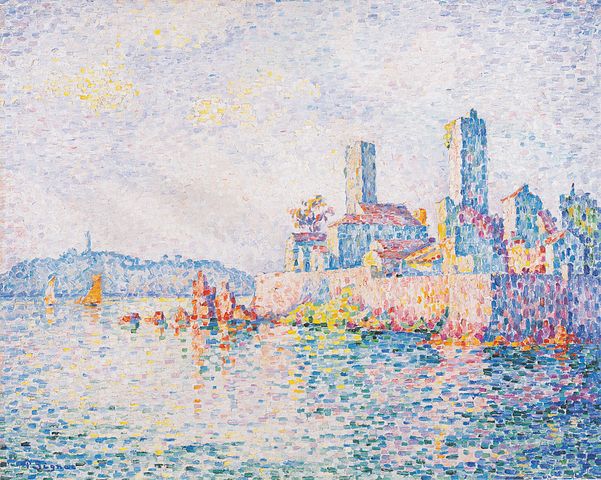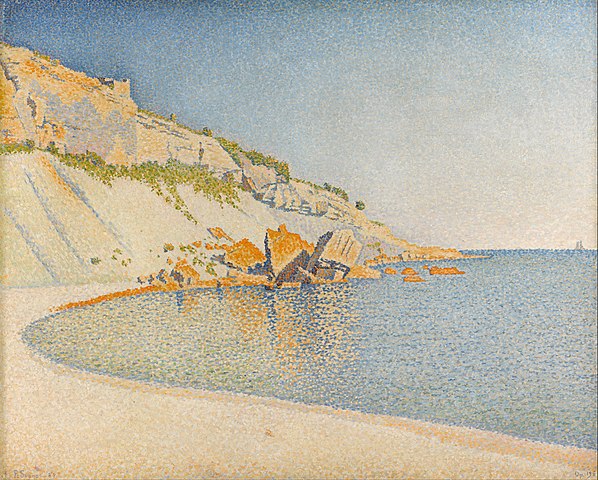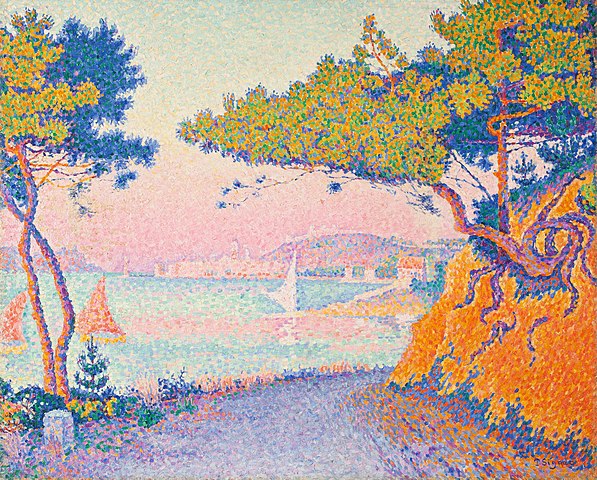
Sometimes artworks in the library can give students useful information about different areas of study, including the Faculties of History, Political Science, Law, Sociology, and others. On the U1 level of the Pridi Banomyong Library, opposite the Charnvit Kasetsiri Room, is a reproduction of a painting by a French artist of the 1800s. Paul Signac’s Snow, Boulevard de Clichy, Paris is in the collection of The Minneapolis Institute of Art in Minneapolis, Minnesota, USA.
At the time the painting was made, the Boulevard de Clichy in the north of Paris was an inexpensive place for artists to live and find space for their studios. Among the painters of the time who lived and worked there were Edgar Degas, James Abbott McNeill Whistler, Honoré Daumier, Jean-Léon Gérôme, and many others. The Thammasat University Library owns a book about art history with a chapter describing the work of Paul Signac, who worked in this area.
Snow, Boulevard de Clichy, Paris shows a number of people crossing the street with difficulty in the harsh winter weather. Signac cared about what happened to these and other people. Like a number of his artist friends, Signac was an anarchist. The TU Libraries own a number of books about anarchism.
The word anarchy originates with a Greek term meaning without authority. Anarchists generally prefer societies that govern themselves, without leaders. They believe that people will volunteer to serve the community if given the opportunity, and they can be trusted to do the right thing. The word anarchy is defined as lawlessness and absence of government. Synonyms for anarchy include chaos, confusion, disorder, hostility, rebellion, riot, turmoil, unrest, disorganization, revolution, mob rule, and reign of terror. Some thoughts about anarchism:
- The ideally non-violent state will be an ordered anarchy. That State is the best governed which is governed the least.
- Mohandas Karamchand Gandhi in Gandhi’s Wisdom Box (1942), edited by Dewan Ram Parkash
- I remember a man whom I knew when I was young, who was small, anemic, and timid, but used to proclaim himself an anarchist. He never realised that his whole existence depended upon police protection, or that in a world without government he would be robbed of all his possessions and left to starve.
- Bertrand Russell, in Mortals and Others: American Essays, 1931-1935 (1998)
Paul Signac enjoyed life in the countryside more than life in cities, so he chose to live in the south of France. He felt that the north of France had too much industry and that a balanced artistic life would also be more moral in the countryside. A number of his paintings show people working together to complete tasks.
The workers benefit from access to shared public resources, such as water supply. They do not rely on privately owned goods to improve their lives. Because they believed in an ideal society, Signac and his friends were sometimes called utopians. One of his paintings is entitled In the Time of Harmony: The Golden Age Is Not in the Past, It is in the Future.
One art historian described the social goals of Signac as expressed through his paintings:
His immense manifesto painting In the Time of Harmony: The Golden Age Is Not in the Past, It Is in the Future, which measures more than nine by thirteen feet, significantly reconfigured traditional associations between the political right and the classical tradition of idealized, orderly, and harmonious landscapes of the Mediterranean. In this and other major works of the 1890s, Signac claimed the Mediterranean coast as a site for politically critical, avant-garde art. In the decades before 1880, avant-garde painters rarely depicted France’s southern shore due, in part, to the cultural affiliation between southern France and academic classicism, in turn linked with cultural and political conservatism… After moving to St-Tropez in 1892, Signac, a committed anarchist, began to paint politicized pastorals juxtaposing north and south and promoting a left-wing vision of the Mediterranean shore.
Two of Signac’s favorite authors were Stendhal and Guy de Maupassant. The TU Library owns a number of books by and about Stendhal and Maupassant. Both of these important French writers lived in the south of France and worked for individual freedom to be expressed. This made the south seem even more promising as a place to live for Signac. Stendhal felt that people in the south of France were happier than those in the north, because in northern cities, people were too worried about making money all the time. In the south, people valued their freedom, including their free time, more. Maupassant added that in the south, people had more time to read books and learn.

Admiring earlier painters
As a teenager, Signac was a fan of the Claude Monet and even wrote him a letter, asking if he could show some of his paintings to Monet, to get his opinion of what he had achieved so far:
Frankly, this is my position: I have been painting for two years, and my only models have been your [Monet’s] own works; I have been following the wonderful path you broke for us. I have always worked regularly and conscientiously, but without advice or help, for I do not know any impressionist painter who would be able to guide me, living as I am in an environment more or less hostile to what I am doing. And so I fear I may lose my way, and I beg you to let me see you, if only for a short visit. I should be happy to show you five or six studies; perhaps you would tell me what you think of them and give me the advice I need so badly, for the fact is that I have the most horrible doubts, having always worked by myself, without teacher, encouragement, or criticism.
Possibly because Monet’s art focused on natural beauty, Signac decided to create paintings that showed a future ideal society. Signac wrote:
When the society that we dream of exists, when rid of the exploiters who exhaust him, the worker will have time to think and to learn. He will appreciate all the qualities of a work of art.
In his independent life in the south, Signac was able to imagine a better future. While he rejected big city life, he was attached to the modern world of nature. As a painter, he wasted to use beautiful colors, but not to paint realistic images. Instead, he wanted to show the artists’ ideals.

(All images courtesy of Wikimedia Commons)

